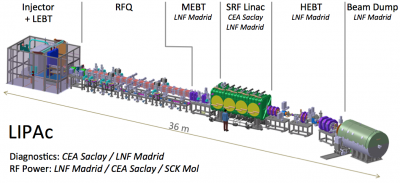IFMIF-EVEDA
Since the Broader Approach agreement in 2007, the IFMIF/EVEDA (IFMIF Engineering Validation and Engineering Design Activities) project is being executed.[1] This project intends to prove the technical feasibility of IFMIF project. The IFMIF/EVEDA project is subdivided in 4 sub-projects:
- IFMIF engineering design
- Validation Activities of the Lithium Loop System
- Validation Activities of the Irradiation Area System
- Validation Activities of the Accelerator System
The first three sub-projects have been completed and the goals achieved. Only the last subproject remains, i.e., the construction of an accelerator prototype similar to the ones planned for IFMIF (named LIPAc, Linear IFMIF Prototype Accelerator). The problems associated with the spatial charge are larger the lower the energy of the beam is, and therefore the major technical issues would be overcome if LIPAc can be built and operated.
The IFMIF-EVEDA accelerator [2] will be a 9 MeV, 125mA cw deuteron accelerator, identical to the low energy section of one of the IFMIF accelerators [3], which will be tested to verify the validity of the design before launching the IFMIF construction. It includes an ion source, a Radiofrequency Quadrupole cavity and the first module of a superconducting linac based on half wave resonator cavities. As no target is foreseen for the accelerated beam, a beam dump is required to stop it during commissioning and accelerator tests. The beam will be validated before the beam stop using non interceptive diagnostics, due to the high intensity in cw mode.
Commissioning and operation plan
To minimize accelerator activation, commissioning will be performed mainly with H2+ pulsed beams with progressively increasing duty factor and current up to the nominal 125 mA current. Therefore the beam dump must be able to stop deuteron and H2+ continuous and pulsed beams with energies 5 MeV (RFQ commissioning) and 9 MeV. The maximum beam power is 1.12 MW corresponding to a beam current of 125 mA. A maximum operation time at full current of D+ of around 1 year and an operation time with 5 Hz pulsed beam with 0.1% duty cycle of 2 months have been assumed.
